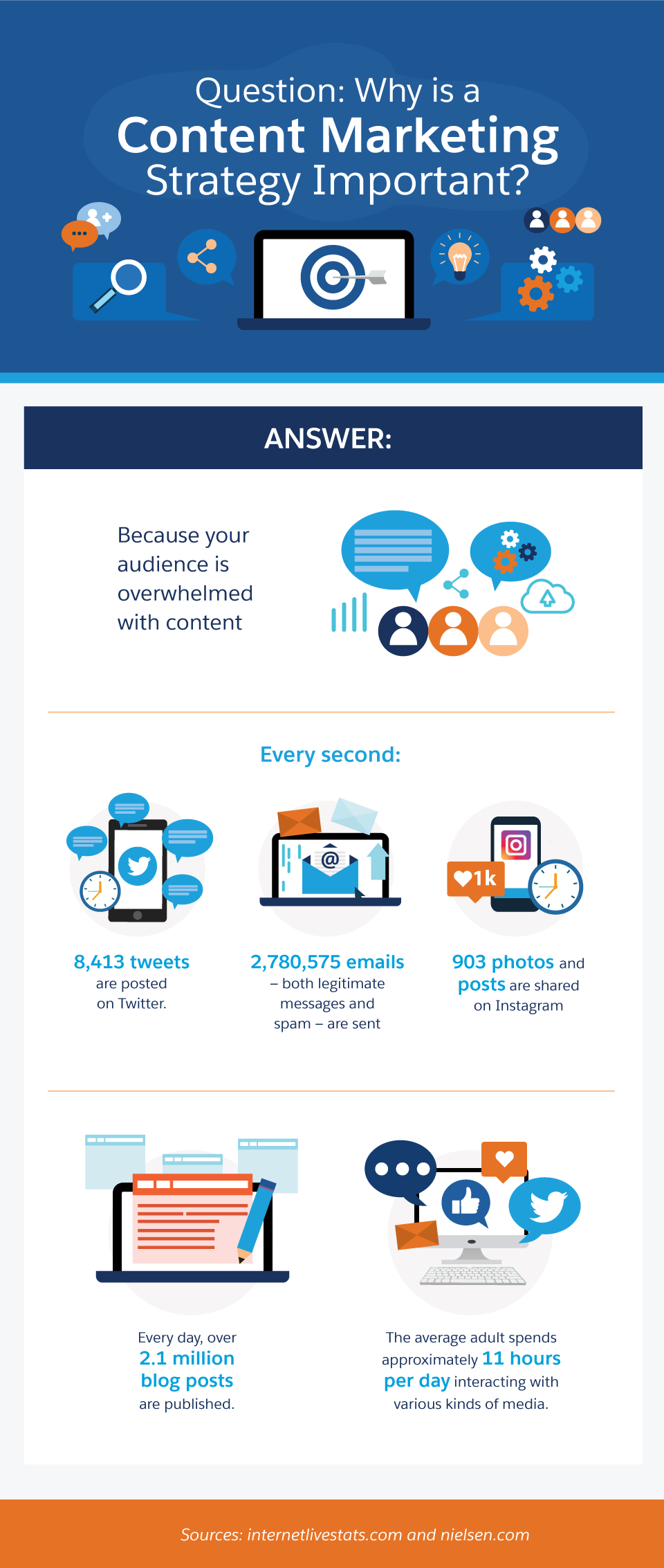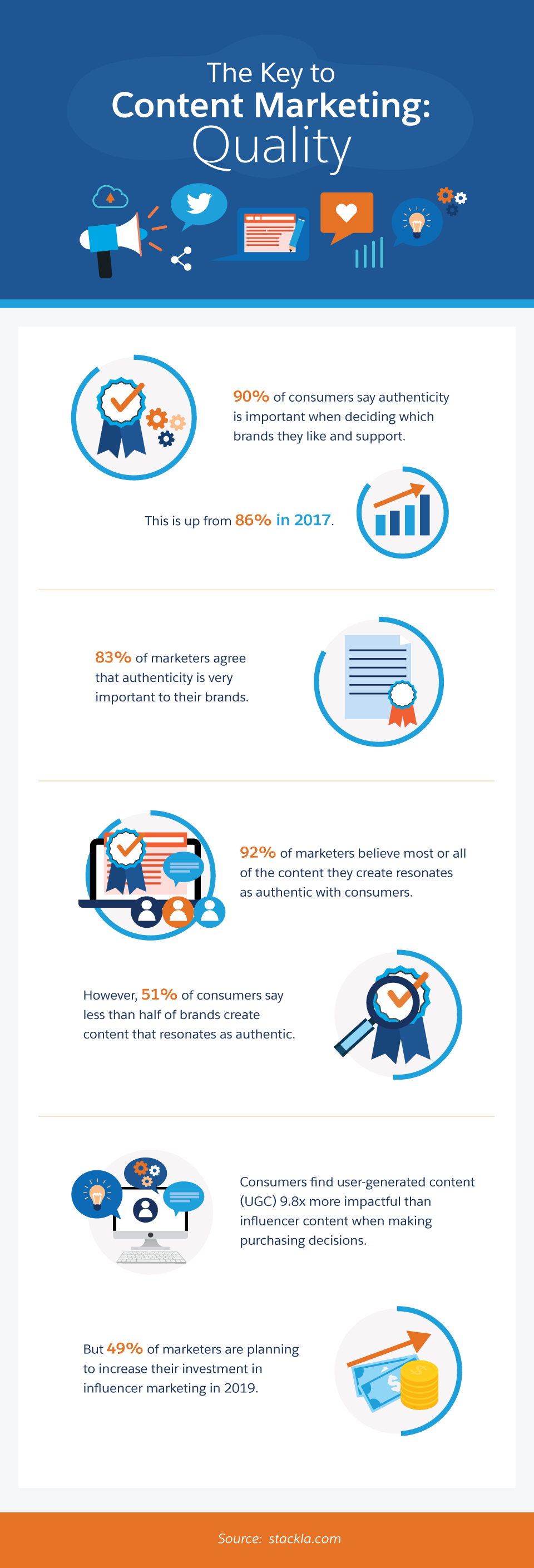What is a Content Marketing Strategy? How Do I Create One?



Content marketing is a powerful tool that, when used strategically, can drastically shape your customer journey, positively impact multiple departments, and help turn customers into advocates.
Kathryn Casna
The world produces a shocking amount of digital content. Every second, 8,413 tweets are posted, 903 photos are uploaded to Instagram, and 2,780,575 emails (legitimate messages and spam) are sent. In one day, over 2.1 million blog posts are published. It seems everyone and their brother, sister, parents, and cat produce content. With so much to see, most adults now spend almost half their day interacting with media.
Content marketing is one way businesses harness all that attention to get in front of customers. Some business leaders swear by content marketing. Others feel it’s a waste of resources. So which is it?
That depends on the company. Companies that find ways to stand out from the sea of so-so content — and monetize that attention — find success, while others struggle to find eyes and ears for their creations.
The best way to ensure you’re in the first group is to make sure your content marketing strategy is on point. This article gives tips and insights into how to do exactly that.
Question: Why is a Content Marketing Strategy Important?
- Answer: Because your audience is overwhelmed with content.
- Every second:
- 8,413 tweets are posted on Twitter.
- 903 photos and posts are shared on Instagram
- 2,780,575 emails — both legitimate messages and spam — are sent.
- Every day, over 2.1 million blog posts are published.
- The average adult spends approximately 11 hours per day interacting with various kinds of media.

What is a content marketing strategy?
The Content Marketing Institute defines content marketing as “a strategic marketing approach focused on creating and distributing valuable, relevant, and consistent content to attract and retain a clearly defined audience — and, ultimately, to drive profitable customer action.”
In short, it’s creating content your customers are excited to consume, that positions you as their go-to source for more of the same. Great content educates and drives the sales funnel.
Content marketing strategy, then, is how you get there.
What Content Marketing Isn’t
Top-performing content marketers have a lot in common: For one, they agree that content marketing is a long-term strategy. Of the most successful B2B content marketing leaders:
- 92 percent focus on building audiences
- 89 percent are extremely or very committed to content marketing
- 88 percent value creativity and craft
- 86 percent are realistic about what content marketing can achieve
- 84 percent have leadership that allows ample time to produce marketing results
It takes time to produce quality, targeted content and build an audience. Furthermore, assessing metrics and showing the ROI of this marketing effort, which doesn’t necessarily have a money-based conversion rate, is difficult.
That means content marketing isn’t a one-off project. It’s not simply posting to a blog or having a lot of social media followers. You have to be committed to it, and you have to be good at it. Because true content marketing requires such a serious investment, your efforts have to really pay off in a way not necessarily tied to your profit margin.
What you need is a content marketing strategy to focus your efforts — and your budget — on what’s most effective for your business.
How to create a content strategy for your company
It’s easy to get lost in creating content for your audience. With so many platforms at your disposal and millions of internet users to connect with, you could create anything for anyone. Strategy is how you reel it all in and focus your efforts on what’s appealing to your audience, their needs, and your bottom line.
Why content marketing?
Effective content marketing strategy starts with two whys: yours and your customers’.
First, ask why you’re using this strategy in the first place. Look at your long-term goals, such as shaping a more educated customer base, building brand authority, ranking in search results, and steering the conversation about your industry and brand.
But more importantly, uncover your customers’ whys. Do they read blog posts, watch videos, and cruise your social media pages to solve problems, understand your products better, or improve their own businesses?
Knowing what your customers’ goals are when they interact with your brand is key to content strategy. If you’re not satisfying a reader’s need, they’ll go elsewhere.
Who are you marketing to?
To understand customer whys, marketers must understand their customers. They choose an audience to create content for, and that means understanding who they’re not creating content for.
If you sell running shoes wholesale in Houston, for example, your audience is likely local shoe stores, department stores, and sporting goods stores. That’s who you’ll build content for. Your audience isn’t shoe stores in San Francisco, health food stores in Houston, or even people who run, so don’t cater to them. If people who don’t buy wholesale running shoes in Houston enjoy your content, that’s wonderful. But they aren’t your customers, so their interests and needs aren’t your priority.
Focus on reaching the people who matter most to your business: your customers. This will help you decide where to invest your content marketing bandwidth.
Being Successful with Content Marketing Takes a Commitment
- Among B2B companies that use content marketing, the difference in commitment is drastic between the most successful content marketing programs versus the least successful.
- Organization is extremely/very committed to content marketing
- Most successful: 89%
- Least successful: 27%
- Has a documented content marketing strategy
- Most successful: 62%
- Least successful: 16%
- Agrees that organization is realistic about what content marketing can achieve
- Most successful: 86%
- Least successful: 45%
- Rates alignment of metrics and content marketing goals as excellent/very good
- Most successful: 54%
- Least successful: 2%

What kinds of content will you create?
The answer to this question depends on who your audience is, what content they consume, and what you’re capable of creating. You’ll find the answer with experimentation, A/B testing, and analytics. Perhaps you’ll find that your B2C customers like shorter content that quickly solves a problem or answers a question in a fun or interesting way. B2B marketers, however, may see better results with pieces that are more in-depth, long-form content that gets to the point quickly and provides value all the way through.
A good B2B content marketing strategy grows the relationship you have with your customers, leads them through the funnel, and speaks directly to their needs. It might involve ebooks on the benefits of your proprietary features, articles on the latest industry news, and artfully designed pitch decks.
Content Capabilities
The content that’s right for your business will satisfy two needs.
- It will be what your audience prefers to consume, be it videos, blog posts, social media posts, white papers, or, most likely, a careful mix.
- It will be what you can create well in a cost-effective way.
Let’s say your audience prefers video content and long-form articles, which you know after analyzing your metrics.
- You can see that most people watched at least half of your video before clicking away. Furthermore, your video posts on Facebook routinely drive engagement.
- Most articles posted on your blog are shared on social media by readers and generate conversation in the form of comments on the blog page. Also, your Time on Page metrics are healthy, indicating people are skimming or reading your articles.
If you have a writing background and can tackle the articles yourself, but upgrading your video content would require you to hire a specialist, start with the articles. Make them the centerpiece of your content marketing strategy. Then add in video after your initial content marketing efforts start paying off and you can increase your budget.
How will you create content?
In house or outsourced: that is the question. If Hamlet had been a content strategist, this question might have been the topic of his monologue. It’s certainly caused plenty of debate among business leaders.
Like deciding what to create, the answer to how you’ll create it depends on what you’re capable of.
You’re an expert at your business, whether that’s running shoes, copy machines, or forklifts. But if you’re not an expert at copywriting, photography, or videography, and you don’t have anyone on your team who is, you might consider outsourcing your content marketing.
There is lots of passable, but low-performing content out there. The key to capturing more attention than your competitors is creating better, more valuable content.
The Key to Content Marketing: Quality
- 90% of consumers say authenticity is important when deciding which brands they like and support
- This is up from 86% in 2017.
- 83% of marketers agree that authenticity is very important to their brands.
- 92% of marketers believe most or all of the content they create resonates as authentic with consumers.
- However, 51% of consumers say less than half of brands create content that resonates as authentic.
- Consumers find user-generated content (UGC) 9.8x more impactful than influencer content when making purchasing decisions.
- But 49% of marketers are planning to increase their investment in influencer marketing in 2019.

When will you publish your content?
No content strategy is complete without a content calendar. This tool allows you to time content creation and publication to maximize its impact. Base your content calendar on several factors.
- When your audience is watching, reading, or listening (peak days and times)
- Seasonality: Holidays, weather, annual events
- Your goals: Upcoming sales, high and low seasons, content cadence
- Your capabilities: How quickly you can produce certain types of content
When to iterate
No content strategy is perfect because there’s no surefire way to know exactly what you’ll need in the future. Create a calendar that stretches several months or a year ahead, but don’t be afraid to tweak or update it regularly.
For example, does your audience seem less interested in blog posts these days, with lower engagement and fewer conversions, but has a growing appetite for ebooks? Switch it up. Or you may discover a single 20-minute deep-dive converts better than a series of quick 2-minute videos. Be ready to investigate and pivot toward creating more of what’s working.
Where will you publish?
Some types of content are a natural fit for certain platforms: photos on Instagram, videos on YouTube, podcasts on Spotify. No matter where your content seems to fit best, consider whether your audience uses that platform. Snapchat is primarily targeting young people and younger generations, but if your audience is business professionals, LinkedIn or another channel is probably a better bet.
Don’t try to be everywhere. If your customers don’t use a channel, don’t invest resources there. On the other hand, it’s wise to diversify. You may have had an incredible presence on Yik Yak, but its demise in 2017 means your company needed to have active accounts elsewhere, too. When there are issues with a channel, you’ll be thankful it wasn’t your only way to reach your audience.
Whatever you do, metrics are important. Use social media, email, SEO, and other content marketing efforts to drive traffic to your website. Measure your efforts, analyze results, and make data-backed decisions.
Your audience awaits
Content marketing is a powerful tool that, when used strategically, can drastically shape your customer journey, positively impact multiple departments, and help turn customers into advocates.
To be most effective, you must create a strategy that addresses the why, who, what, how, when, and where of your content marketing efforts. And in many companies, a solid strategy is the key to buy-in from the C-suite team, too. So start creating your strategy today.
Share “What is a Content Marketing Strategy? How Do I Create One?” On Your Site























